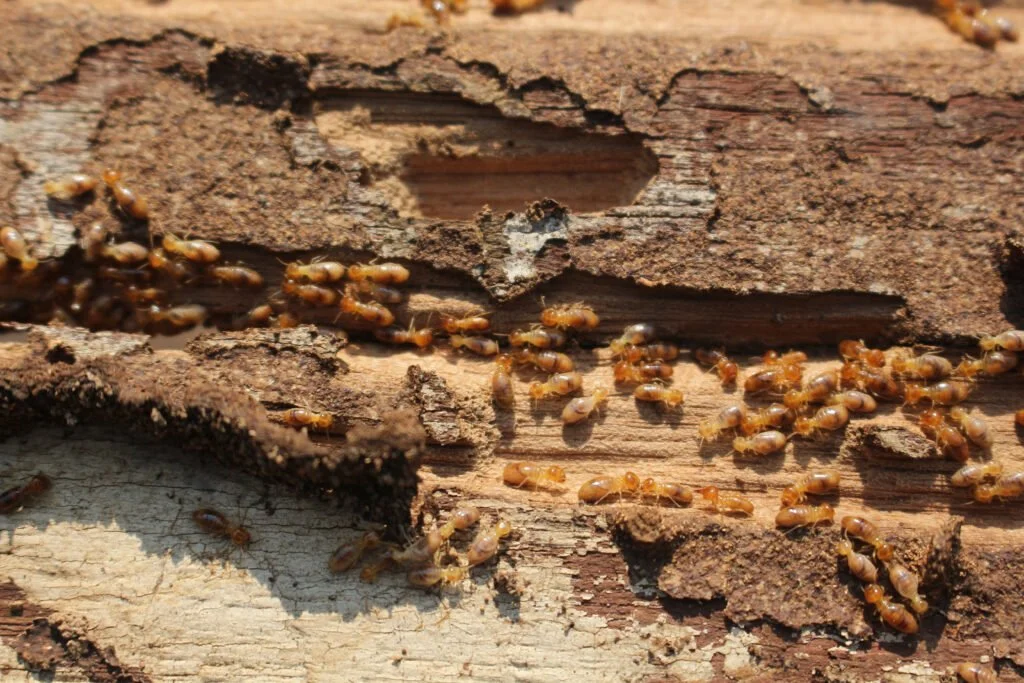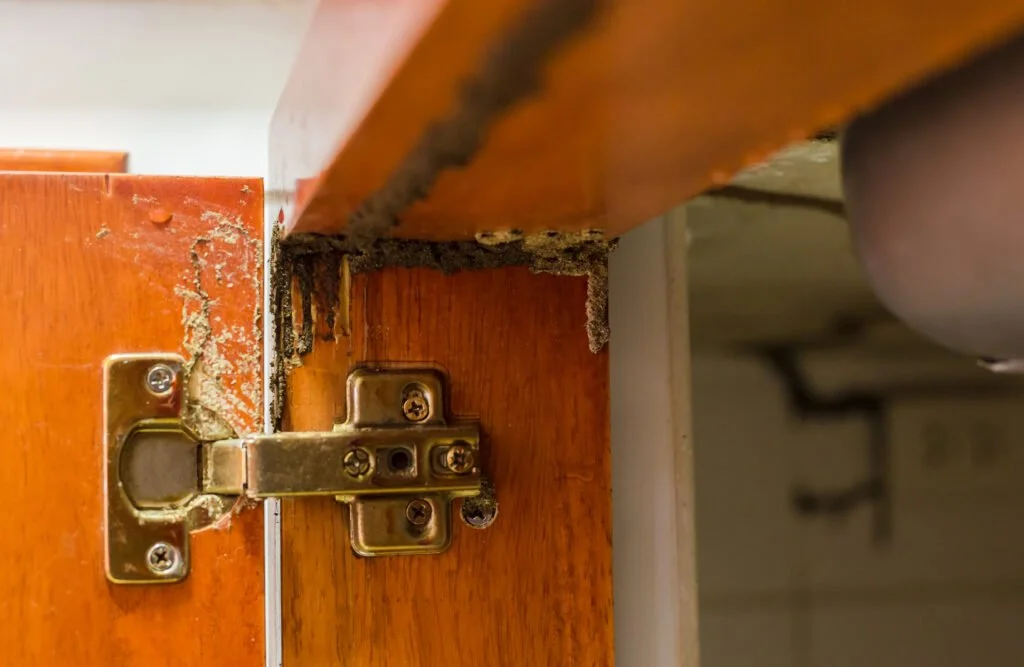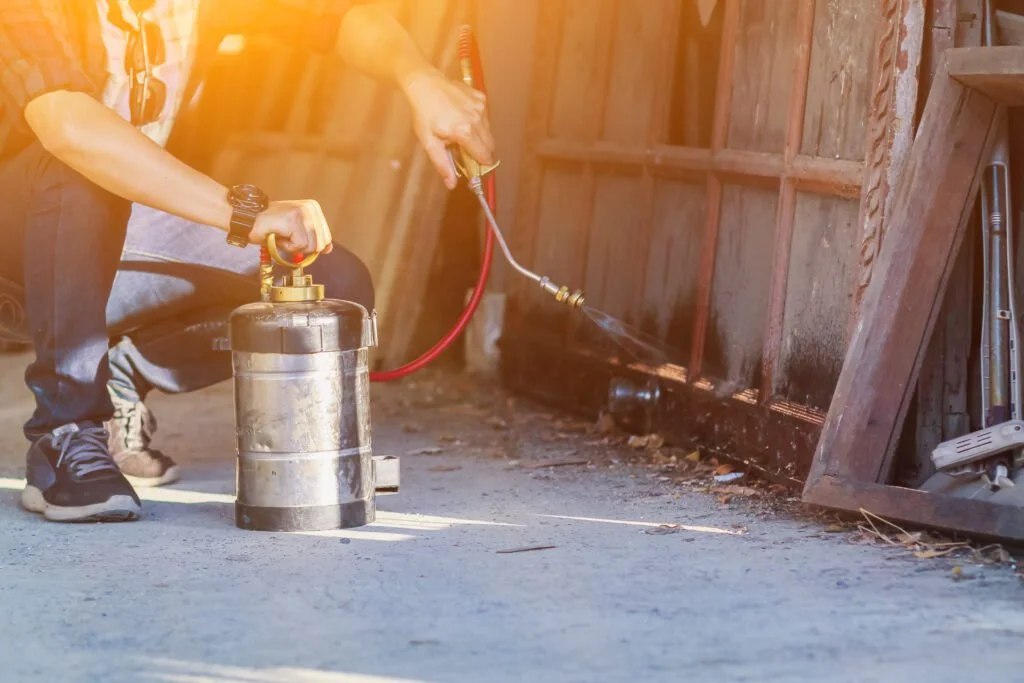Mud tubes snaking up the foundation… hollow sounds when you knock the wall…
Do you have termites in your house? If you suspect that you’ve got house termites, you’ve got to act immediately. These insidious pests can create a lot of damage, often causing serious problems before you even know they exist.
If termites are terrorizing your home, you’re definitely not alone. Each year, termites damage about 600,000 homes in the U.S. alone, says Orkin Pest Control.
And that damage isn’t cheap to fix; collectively, U.S. homeowners spend about $5 billion on termite control and even more to repair the havoc these hungry insects wreak.
To make matters worse, termites can be a real deal-breaker when it comes time to sell your home. Here’s what you need to know about dealing with house termites, from identification and treatment to repair.
What are the Signs of Termites in Your Home?
Let’s start with the basics: How do you know if you have house termites? Here are eight signs that indicate you may have termites in your home.
1. Termite Mud Tubes
The first clue you have a termite issue often comes from a strange phenomenon: Long, brown tubes that snake up and down walls, on foundations, across floors, and even on the ceiling.
For many homeowners, these tubes are so unexpected and odd that they’re baffled when they first appear.
What, exactly, are these strange structures? Also known as “shelter tubes,” termites build them like highways.
The tunnels allow insects to easily travel from one part of the house to another without even coming out into the open, where they’re exposed to dry air.
When inspected up close, the tubes appear to be constructed from mud. In fact, termites create shelter tubes from a mixture of soil, wood particles, termite droppings (called “frass”), and other debris.
The inside of the tubes stays moist, acting as a bridge that allows the insects to travel from food sources to their colony with ease.
Most often, termites build tubes on or near your home’s foundation, on the edge of the slab, or in a basement or crawl space. However, you may find tubes anywhere.
If you spot a tube, break off a one-inch piece. If termites emerge or if the tube is rebuilt within the next few days, you’ve got an infestation.

2. Swarming Termites
At certain times of year, usually fall or spring, large groups of newly mature termites (known as “alates”) leave the nest to start new colonies.
Known as a “swarm,” the termites are attracted to warmth and light. They travel in groups and often congregate near windows and doors.
3. Hollow Wood
Give wooden structures in your house a knock. Do they sound hollow? If so, you may have termites.
The insects tunnel through wood, leaving paths of destruction that run along the wood’s grain.
Sometimes the hollow spaces create cracks on the wood’s surface. All too often, though, damage remains hidden until it’s serious.
4. Discarded Wings
Look around the edges of windows and doors. If you spot numerous discarded insect wings, you may have termites. When swarms encounter a closed window or door, they often stay there until they shed their wings.
At that point, they head back into wood, walls, or the soil to their colony. Piles of wings on window sills, in spider webs, and around door frames may indicate an infestation.
5. Droppings and Frass
Termites leave behind tiny pellets known as frass. Frass is the color of the wood and may look like sawdust or even coffee grounds.
Termites like to keep their paths clear, so they may move droppings to the side. Often, you’ll find small piles of frass in infested areas.
6. Swelling on Floors or Walls
Do you notice swollen or raised areas on walls or floors? Maybe you assumed it was water damage… but it could be termites.
The insects may be burrowing just beneath the surface, causing the wood to bulge or swell. Bubbling paint may be another indication of house termites.

7. Sounds From the Walls
Believe it or not, you can actually hear termites chewing. Put your head close to a wall (or use a stethoscope) and listen for munching sounds.
Some termites hit their heads against wood or shake their bodies in order to send messages to the rest of the colony. If you hear soft clicking sounds in the walls, this may indicate a termite infestation.
8. Termite Bodies
Though it’s rare, you may actually find dead termites in your home. They may resemble flying or white ants.
What Do House Termites Look Like?
There are over 40 species of termites in the U.S. The insects fall into four general types:
- Subterranean: The most common type of termite, these insects live in massive underground colonies that can tunnel up to 150 feet
- Formosan: Aggressive wood eaters that often build mud tubes high on walls or ceilings
- Drywood: Commonly found in the southwestern and southeastern U.S., they live in wooden structures and even furniture
- Dampwood: Smaller termites that live where wood and damp combine, such as basements and crawlspaces
Most share a few characteristics:
- About 1/4 to 1/2 inch in length
- Non-segmented bodies
- Straight antennae
- Light to dark brown in color
Termite colonies contain different castes or categories of insect:
- Nymphs (immature termites) are light, soft, and resemble larvae
- Workers tend to be small and light in color
- Soldiers have soft, light bodies and dark heads with large jaws
- Alates or swarmers have wings and darker bodies
It’s easy to mistake termites for flying ants. While they do look alike, ants have segmented bodies and differently sized wings. Termites have same-size wings and non-segmented bodies.
What Attracts Termites in the House?
Termites are attracted to food sources… and for these hungry insects, that means wood. Termites eat wood and other plant matter, such as paper, and insulation, for the cellulose it contains.
Depending on the species, some termites prefer dry wood, while others are more attracted to soft, damp wood.
As a homeowner, avoid the following to deter termites:
- Standing water or moisture issues in basements, crawl spaces, and around the home that softens wood and makes it easy for termites to tunnel in.
- Wood piles: While having wood stacked near (or even in) your home is convenient when you have a fireplace, woodpiles also attract termites. Instead, keep woodpiles stacked away from the walls of your home.
- Mulch may look fantastic and keep weeds down in flower beds, but to termites, it’s nothing more than a tasty food source. When mulch is laid next to your home’s foundation, it’s easy for termites to get in. Keep mulch from touching your home’s foundation by installing a barrier.
- Tree stumps: Removing tree stumps can be costly and difficult, but as the wood softens and rots, it attracts termites. When termites move into a tree stump near your home, it’s only a matter of time before they move into your walls.
- Cellars, basements, and crawl spaces: The spaces under your home are notorious for gathering and holding moisture… and many species of termites love nothing more than a damp, dark space, especially when wooden supports are there, too.
- Roof issues can serve as an open invitation to termites. From clogged rain gutters that hold moisture to tree branches that touch your house and act as a bridge, roof problems can lead to termite problems.
Keep in mind that termites can slip through cracks as small as 1/32 of an inch.
That means they may enter your home almost anywhere, whether from the dirt, a tree branch, the roof, wood or stumps on your property, your foundation, your deck or your porch.
Can You Have Termites and Not Know It?
Not only can you have house termites and not know it, but this is also actually the norm for many homeowners. In many cases, termites can enter a home and much away on wood without leaving much evidence.
In fact, if you don’t know what to look for, termites may infest your home undetected for months or even years.
According to House Logic, it often takes from three to eight years before the signs of damage — even serious damage — become apparent.
Unfortunately, the longer the termites are left unchallenged, the more damage they cause. That’s why it’s important to look for signs of termite infestation regularly and call in professionals when needed.
How Do I Get Rid of Termites in My House?
If you find signs of a termite infection, call in the professionals immediately. It’s hard to know how long the termites have been causing damage, and it’s important to treat the home right away.
The best type of treatment depends on the type of termites and the extent of the problem.

Treating Subterranean Termites
Subterranean termites are among the most destructive types. These insects live in the soil and are often responsible for building mud tunnels. Treatment options for subterranean termites include:
- Termiticides that create a barrier around your home’s exterior. Termites eat wood treated with the poison, take it back to the colony with them, and spread it to other insects
- Direct chemicals, such as foams, that can be shot into cracks and crevices; usually lasts up to a month
- Baits are installed around your home’s foundation; these slow-acting poisons attract termites, who eat them, spread them to others in the colony, then die before they molt
- Beneficial nematodes are a natural control method; these parasites can kill termites within a few days
Treating Drywood Termites
Drywood termites often eat support joints. They can weaken your home’s structure and cause a lot of damage. Treatment options may include:
- Spot treatment involves drilling holes into the wood at regular intervals, filling the holes with termiticide, then covering the hole openings with putty
- Fumigation and/org tenting service
Treating Formosan and Dampwood Termites
Formosan termites are less common, but they’re very destructive and hard to eradicate. Often, treatment involves digging trenches around the home and pouring or spraying termiticide into the dirt. Fumigation may also be necessary.
Dampwood termites are larger insects that don’t build mud tubes. This makes them difficult to detect. To treat a damp wood infestation, a termiticide is often used in wood. Moisture and standing water problems must also be resolved.
What Kills Termites Instantly?
Many termite treatments are based on termiticides that work slowly. Many act as bait, attracting an insect that eats the poison, then takes it back to the colony and spreads its effects.
While these chemicals don’t kill termites right away, they are an effective way to disable a colony.
If you spot live termites in your home, you can try a few substances to instantly kill them. Bleach may do the trick, as will certain insecticides that you can purchase at home improvement stores.
You may also want to try:
- Boric acid; spray around affected areas to dehydrate insects
- Orange oil dissolves termites’ exoskeletons
- Vinegar and lemon juice may kill termites on contact
- Diatomaceous earth; sprinkle around affected areas to dehydrate termites
Unfortunately, getting rid of house termites isn’t a DIY job. You really need to call professionals to make sure the insects are under control; there’s just too much potential for serious damage on the line to take a risk.
What Happens if You Don’t Take Care of Termites?
If you ignore a termite infestation, the insects will continue to cause damage. Not only will they eat wood, but they’ll also munch on insulation and drywall. Often, the damage is structural and serious.
Sagging floors, bulging walls, bubbling paint, doors, and windows that won’t open and shut properly are just a few results of termite activity.
Over time, termites will literally eat through the structural support of your home, creating serious safety hazards…. and keep in mind that termite queens can live for decades.
Why would someone ignore a termite problem? For many homeowners, the cost of taking care of termites is simply too much.
How Much Does it Cost to Treat a House for Termites?
Treating a house for termites is essential. But many homeowners aren’t able to afford the expenses out of pocket.
According to Bob Vila, the cost of typical termite treatment will range from $221 to $916, with an average cost of about $568. Treatment costs break down to an average of:
- Chemical treatment: $3 to $16 per linear foot
- Electro-gun or microwave treatments: Up to $1,150
- Termite bait treatment: $8 to $12 per linear foot
- Liquid termiticides: $8 to $20
- Tenting and heat treatment: $800 to $2,500 for whole house
- Fumigation: $10 to $20 per linear foot
Of course, every house termite infestation is unique. Several factors play a role in determining the cost of termite treatment, such as:
- Size of the home
- Extend of the termite infestation
- The type of termites
- The type and number of treatments required
For instance, drywood termite treatment costs range up to $2,500. This type of termite usually requires chemical injections or baits, as well as house tenting. House tenting treatment for termites often costs more than $2,000.
Dampwood termite treatment runs up to about $2,500 and usually requires fixing standing water issues. Subterranean termite treatment usually ranges from $281 to $868.
However, if a whole-house treatment is required, costs may reach over $2,500.
How Do I Permanently Get Rid of Termites in My House?
Once the treatment is done, keeping termites away is key. One common solution lies in termite monitoring stations.
The stations are placed around the home and a pest control professional will check them regularly. If termite activity is detected, bait can be added to the stations. Monitoring stations cost about $40 apiece.
Even if termites are kept at bay, you still need to repair the damage caused by these destructive pests.
When you consider that a colony can eat up to 13 ounces of wood per day, it’s easy to see why termite treatment is simply the first step.
Common termite-related repair costs include:
- Drywall repair, average cost $500
- Framing repair, average cost $1,050
- Attic insulation install, average cost $1,900
- Crawlspace repair and cleaning, up to $6,000
Getting rid of termites — and keeping them away for good — isn’t cheap or easy, but it is necessary. If you don’t take care of house termites, they’ll cause damage that will end up costing much more in the long run.
What happens when you want to sell your house and you have termites? You’ll have to disclose it to the buyers.
In many cases, potential home buyers won’t want to take a risk on a house that needs so much in terms of treatment and repair.
If you can’t shoulder the expense of termite treatment and repair, you have options: Sell to HomeGo.
HomeGo buys homes as-is — even homes that have termites or need repair. Contact HomeGo today to speak with an agent. Learn how you can get a transparent offer and close your home within just a few weeks.




